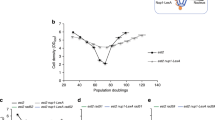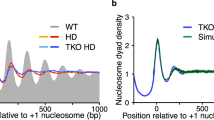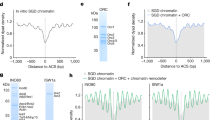Abstract
The functional regulation of chromatin is closely related to its spatial organization within the nucleus. In yeast, perinuclear chromatin domains constitute areas of transcriptional repression1,2,3. These ‘silent’ domains are defined by the presence of perinuclear telomere clusters4. The only protein found to be involved in the peripheral localization of telomeres is Yku70/Yku80 (ref. 5). This conserved heterodimer6 can bind telomeres7 and functions in both repair of DNA double-strand breaks8,9,10,11 and telomere maintenance7,12,13,14,15. These findings, however, do not address the underlying structural basis of perinuclear silent domains. Here we show that nuclear-pore-complex extensions formed by the conserved TPR16,17 homologues Mlp1 and Mlp218,19 are responsible for the structural and functional organization of perinuclear chromatin. Loss of MLP2 results in a severe deficiency in the repair of double-strand breaks. Furthermore, double deletion of MLP1 and MLP2 disrupts the clustering of perinuclear telomeres and releases telomeric gene repression. These effects are probably mediated through the interaction with Yku70. Mlp2 physically tethers Yku70 to the nuclear periphery, thus forming a link between chromatin and the nuclear envelope. We show, moreover, that this structural link is docked to nuclear-pore complexes through a cleavable nucleoporin, Nup14520. We propose that, through these interactions, nuclear-pore complexes organize a nuclear subdomain that is intimately involved in the regulation of chromatin metabolism.
This is a preview of subscription content, access via your institution
Access options
Subscribe to this journal
Receive 51 print issues and online access
$199.00 per year
only $3.90 per issue
Buy this article
- Purchase on Springer Link
- Instant access to full article PDF
Prices may be subject to local taxes which are calculated during checkout




Similar content being viewed by others
References
Maillet,L. et al. Evidence for silencing compartments within the yeast nucleus: a role for telomere proximity and Sir protein concentration in silencer-mediated repression. Genes Dev. 10, 1796–1811 (1996).
Andrulis,E. D., Neiman,A. M., Zappulia,D. C. & Sternglanz,R. Perinuclear localization of chromatin facilitates transcriptional silencing. Nature 394, 592–595 (1998); erratum, ibid 395, 525 (1998).
Gottschling,D. E., Aparicio,O. M., Billington,B. L. & Zakian,V. A. Position effect at S. cerevisiae telomeres: reversible repression of Pol II transcription. Cell 63, 751–762 (1990).
Gotta,M. et al. The clustering of telomeres and colocalization with Rap1, Sir3, and Sir4 proteins in wild-type Saccharomyces cerevisiae. J. Cell Biol. 134, 1349–1363 (1996).
Laroche,T. et al. Mutation of yeast Ku genes disrupts the subnuclear organization of telomeres. Curr. Biol. 8, 653–656 (1998).
Feldmann,H. et al. HDF2, the second subunit of the Ku homologue from Saccharomyces cerevisiae. J. Biol. Chem. 271, 27765–27769 (1996).
Gravel,S., Larrivee,M., Labrecque,P. & Wellinger,R J. Yeast Ku as a regulator of chromosomal DNA end structure. Science 280, 741–744 (1998).
Milne,G. T., Jin,S., Shannon,K. B. & Weaver,D. T. Mutations in two Ku homologs define a DNA end-joining repair pathway in Saccharomyces cerevisiae. Mol. Cell. Biol. 16, 4189–4198 (1996).
Boulton,S. J. & Jackson,S. P. Saccharomyces cerevisiae Ku70 potentiates illegitimate DNA double-strand break repair and serves as a barrier to error-prone DNA repair pathways. EMBO J. 15, 5093–5103 (1996).
Moore,J. K. & Haber,J. E. Cell cycle and genetic requirements of two pathways of nonhomologous end-joining repair of double-strand breaks in Saccharomyces cerevisiae. Mol. Cell. Biol. 16, 2164–2173 (1996).
Barnes,G. & Rio,D. DNA double-strand-break sensitivity, DNA replication, and cell cycle arrest phenotypes of Ku-deficient Saccharomyces cerevisiae. Proc. Natl Acad. Sci. USA 94, 867–872 (1997).
Porter,S. E., Greenwell,P. W., Ritchie,K. B. & Petes,T. D. The DNA-binding protein Hdf1p (a putative Ku homologue) is required for maintaining normal telomere length in Saccharomyces cerevisiae. Nucleic Acids Res. 24, 582–585 (1996).
Boulton,S. J. & Jackson,S. P. Components of the Ku-dependent non-homologous end-joining pathway are involved in telomeric length maintenance and telomeric silencing. EMBO J. 17, 1819–1828 (1998).
Nugent,C. I. et al. Telomere maintenance is dependent on activities required for end repair of double-strand breaks. Curr. Biol. 8, 657–660 (1998).
Polotnianka,R. M., Li,J. & Lustig,A. J. The yeast Ku heterodimer is essential for protection of the telomere against nucleolytic and recombinational activities. Curr. Biol. 8, 831–834 (1998).
Cordes,V. C., Reidenbach,S., Rackwitz,H. R. & Franke,W. W. Identification of protein p270/Tpr as a constitutive component of the nuclear pore complex-attached intranuclear filaments. J. Cell Biol. 136, 515–529 (1997).
Bangs,P. et al. Functional analysis of Tpr: identification of nuclear pore complex association and nuclear localization domains and a role in mRNA export. J. Cell Biol. 143, 1801–1812 (1998).
Kolling,R., Nguyen,T., Chen,E. Y. & Botstein,D. A new yeast gene with a myosin-like heptad repeat structure. Mol. Gen. Genet. 237, 359–369 (1993).
Strambio-de-Castillia,C., Blobel,G. & Rout,M. P. Proteins connecting the nuclear pore complex with the nuclear interior. J. Cell Biol. 144, 839–855 (1999).
Teixeira,M. T., Fabre,E. & Dujon,B. Self catalysed cleavage of the yeast nucleoporin Nup145p precursor. J. Biol. Chem. 274, 32439–32444 (1999).
Martin,S. G., Laroche,T., Suka,N., Grunstein,M. & Gasser,S. M. Relocalization of telomeric Ku and SIR proteins in response to DNA strand breaks in yeast. Cell 97, 621–633 (1999).
Shore,D. Telomere length regulation: getting the measure of chromosome ends. Biol. Chem. 378, 591–597 (1997).
Schimmang,T., Tollervey,D., Kem,H., Frank,R. & Hurt,E. C. A yeast nucleolar protein related to mammalian fibrillarin is associated with small nucleolar RNA and is essential for viability. EMBO J. 8, 4015–4025 (1989).
Lee,S. E. et al. Saccharomyces Ku70, mre11/rad50 and RPA proteins regulate adaptation to G2/M arrest after DNA damage. Cell 94, 399–409 (1998).
Trelles-Sticken,E., Loidl,J. & Scherthan,H. Bouquet formation in budding yeast: initiation of recombination is not required for meiotic telomere clustering. J. Cell Sci. 112, 651–658 (1999).
Blobel,G. Gene gating: a hypothesis. Proc. Natl Acad. Sci. USA 82, 8527–8529 (1985).
Mages,G. J., Feldmann,H. M. & Winnacker,E. L. Involvement of the Saccharomyces cerevisiae HDF1 gene in DNA double-strand break repair and recombination. J. Biol. Chem. 271, 7910–7915 (1996).
Kilmartin,J. V. & Adams,A. E. Structural rearrangements of tubulin and actin during the cell cycle of the yeast Saccharomyces. J. Cell Biol. 98, 922–933 (1984).
Aris,J. P. & Blobel,G. Yeast nuclear envelope proteins cross react with an antibody against mammalian pore complex proteins. J. Cell Biol. 108, 2059–2067 (1989).
Olivo,J.-C. Automatic detection of spots in biological images by a wavelet-based selective filtering technique. Proc. IEEE Int. Conference on Image Processing ICIP 1996, 311–314 (1996).
Author information
Authors and Affiliations
Supplementary information
Rights and permissions
About this article
Cite this article
Galy, V., Olivo-Marin, JC., Scherthan, H. et al. Nuclear pore complexes in the organization of silent telomeric chromatin. Nature 403, 108–112 (2000). https://doi.org/10.1038/47528
Received:
Accepted:
Issue Date:
DOI: https://doi.org/10.1038/47528
This article is cited by
-
A short linear motif in scaffold Nup145C connects Y-complex with pre-assembled outer ring Nup82 complex
Nature Communications (2017)
-
A regression model approach to enable cell morphology correction in high‐throughput flow cytometry
Molecular Systems Biology (2011)
-
The nuclear envelope in genome organization, expression and stability
Nature Reviews Molecular Cell Biology (2010)
-
Karyopherin binding interactions and nuclear import mechanism of nuclear pore complex protein Tpr
BMC Cell Biology (2009)
-
Chromatin: linking structure and function in the nucleolus
Chromosoma (2009)
Comments
By submitting a comment you agree to abide by our Terms and Community Guidelines. If you find something abusive or that does not comply with our terms or guidelines please flag it as inappropriate.



